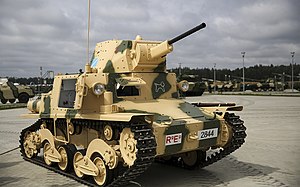| Carro Armato L6/40 | |
|---|---|
 Restored L6/40 of Kubinka Tank Museum | |
| Type | Light tank |
| Place of origin | Italy |
| Service history | |
| In service | 1940–1944, postwar to the early 1950s |
| Used by | Italy Nazi Germany Italian Social Republic Independent State of Croatia |
| Wars | World War II |
| Production history | |
| Designer | Ansaldo |
| Designed | 1939 |
| Manufacturer | Fiat |
| Produced | 1939–1944? |
| No. built | 419 (402 before the armistice and 17 afterwards) [1] |
| Variants | Command tank, flame tank, ammunition carrier, Semovente 47/32 |
| Specifications | |
| Mass | 6.8 tonnes (7.5 short tons; 6.7 long tons) |
| Length | 3.78 m (12 ft 5 in) |
| Width | 1.92 m (6 ft 4 in) |
| Height | 2.03 m (6 ft 8 in) |
| Crew | Two (commander/gunner and driver) |
| Armour | 6–40 mm (0.24–1.57 in) |
Main armament | 20 mm Breda 35 with 296 rounds |
Secondary armament | 8 mm Breda 38 machine gun with 1,560 rounds |
| Engine | SPA 180 4,053 cc four-cylinder 70 hp (52 kW) |
| Suspension | Bogie |
Operational range | 200 km (120 mi) |
| Maximum speed | 42 km/h (26 mph) road |
The L6/40 was a light tank used by the Italian army from 1940 through World War II.[2][3] It was designed by Ansaldo as an export product, and was adopted by the Italian Army when officials learned of the design and expressed interest.[3] It was the main tank employed by the Italian forces fighting on the Eastern Front alongside the L6/40-based Semovente 47/32 self-propelled gun. L6/40s were also used in the North African campaign.[3]
The official Italian designation was Carro Armato ("armored vehicle", i.e. "tank") L6/40. This designation means: "L" for Leggero ("light"), followed by the weight in tons (6) and the year of adoption (1940).
- ^ Cappellano, Filippo; Battistelli, Pier Paolo. Italian Medium Tanks (New Vanguard) (p. 67). Bloomsbury Publishing.
- ^ "FIAT-Ansaldo Carro Armato L6/40". www.tanks-encyclopedia.com. Retrieved 7 December 2021.
- ^ a b c "Carro Armato L6/40". www.militaryfactory.com. Retrieved 7 December 2021.